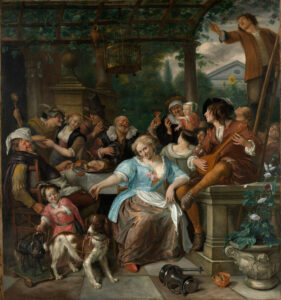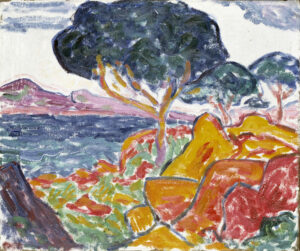
In this painting from 1818, Géricault transports us to a late-day landscape, where nature and architecture combine in dramatic harmony. The imposing Roman aqueduct of Spoleto, a majestic vestige of antiquity, cuts across the horizon with its regular arches, while the golden light of sunset ignites the turbulent sky.
In the foreground, figures—like miniature actors against the immensity of the setting—rest on the banks or bathe in a peaceful stream. The masterful composition plays with contrasts: the monumental solidity of architecture dialogues with the fluidity of threatening clouds; the warmth of orange sunset tones opposes the bluish shadows of steep cliffs. Slender cypresses and wild vegetation add a touch of mystery to this scene where nature’s grandeur rivals that of human constructions.
Additional Information
- Evening: Landscape with an Aqueduct by Théodore Géricault, 1818
- 250.2 x 219.7 cm
- The Metropolitan Museum of Art, Fifth Avenue, New York, Gallery 802
- https://www.metmuseum.org/art/collection/search/436455
Théodore Géricault (1791-1824) is one of the leading figures of French Romanticism. His short career was marked by exceptional creative intensity. Trained in the neoclassical tradition, he quickly moved away from it to develop a personal style where passion and drama take precedence over reason.
Although primarily known for his love of horses, his battle scenes, and his masterpiece “The Raft of the Medusa,” his Italian landscapes reveal a particular sensitivity to atmospheric effects and the evocative power of nature. This series depicting moments of the day, unfortunately unfinished, demonstrates his technical mastery and ability to instill a profound emotional dimension into his compositions.






